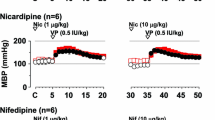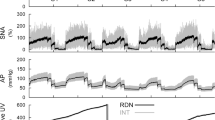Summary
Alpha2-adrenoceptor-mediated coronary constriction contributes to the precipitation of myocardial ischemia during sympathetic activation. Felodipine is a novel dihydropyridine calcium-channel antagonist with vascular selectivity. In this study, the effect of felodipine on alpha2-adrenoceptor-mediated poststenotic coronary constriction was investigated. In ten open-chest dogs, the selective alpha2-adrenoceptor agonist BHT 933 (200 μg IC) was infused before and after production of a severe stenosis on the left circumflex coronary artery. BHT 933 increased calculated resistance of the intact left circumflex coronary artery from 1.16±0.30 (SD) to 2.00±0.70 mmHg*min*100 g/ml (p<0.05) without changing posterior systolic wall thickening (sonomicrometry) (14.2±2.8% vs. 14.1±2.7%). In the presence of a severe stenosis, BHT 933 increased poststenotic coronary resistance from 1.59±0.54 to 2.88±1.16 mmHg*min*100 g/ml (p<0.05) and decreased posterior systolic wall thickening from 11.9±2.7% to 8.2±3.1% (p<0.05). In contrast, after intravenous pretreatment with felodipine (4 μg/kg), intracoronary infusion of BHT 933 did not change coronary resistance (1.69±0.61 vs. 1.61±0.64 mmHg*min*100 g/ml) and posterior systolic wall thickening (12.1±3.0% vs. 12.6±2.9%).
In conclusion, felodipine prevents alpha2-adrenoceptor-mediated coronary constriction and ischemic regional myocardial dysfunction distal to a severe coronary stenosis.
Similar content being viewed by others
References
Schulz R, Guth BD, Heusch G. Pharmacological mechanisms to attenuate sympathetically induced myocardial ischemia.Cardiovasc Drugs Ther 1989;3:43–56.
Gould KL, Lipscomb K, Calvert C. Compensatory changes of the distal coronary vascular bed during progressive coronary constriction.Circulation 1975;51:1085–1094.
Heusch G, Deussen A. The effects of cardiac sympathetic nerve stimulation on the perfusion of stenotic coronary arteries in the dog.Circ Res 1983;53:8–15.
Seitelberger R, Guth BD, Heusch G, et al. Intracoronary α2-adrenergic receptor blockade attenuates ischemia in conscious dogs during exercise.Circ Res 1988;62:436–442.
Mudge GH, Goldberg S, Gunther S, et al. Comparison of metabolic and vasoconstrictor stimuli on coronary vascular resistance in man.Circulation 1979;59:544–550.
Berkenboom GM, Abramowicz M, Vandermoten P, et al. Role of alpha-adrenergic coronary tone in exercise-induced angina pectoris.Am J Cardiol 1986;57:195–198.
Chen DG, Dai X-Z, Zimmerman BG, et al. Postsynaptic α1 and α2-adrenergic mechanisms in coronary vasoconstriction.J Cardiovasc Pharmacol 1988;11:61–67.
Holtz J, Saeed M, Sommer O, et al. Norepinephrine constricts the canine coronary bed via postsynaptic α2-adrenoceptors.Eur J Pharmacol 1982;82:199–202.
Deussen A, Heusch G, Thämer V. α2-adrenoceptor-meditiated coronary vasoconstriction persists after exhaustion of coronary dilator reserve}.Eur J Pharmacol 1985;115: 147–153.
van Zwieten PA, van Meel JCA. Timmermans PBMWM. Functional interaction between calcium antagonists and the vasoconstriction induced by the stimulation of postsynaptic α2-adrenoceptors.Circ Res 1983;52(Suppl I):77–80.
Motulsky HJ, Snavely MD, Hughes RJ, et al. Interaction of verapamil and other calcium channel blockers with α1 and α2-adrenergegic receptors.Circ Res 1983;52:226–231.
Heusch G, Deussen A. Nifedipine prevents sympathetic vasoconstriction distal to severe coronary stenoses.J Cardiovasc Pharmacol 1984;6:378–383.
Ljung B. Vascular selectivity of felodipine.Drugs 1985; 29:46–58.
Verdouw PD, Wolffenbuttel BHR, Scheffer MG, Cardiovascular actions of the calmodulin inhibitor felodipine.Naunyn Schmiedebergs Arch Pharmacol 1983;323:350–354.
Sjöquist PO, Adler G, Duker G, et al. Effects of felodipine, a new dihydropyridine vasodilator, on regional myocardial blood flow during acute coronary occlusion in the pig.J Cardiovasc Pharmacol 1983;5:202–206.
Sjöquist PO, Duker G, Almgren O. Coronary collateral blood flow in acute myocardial ischemia is not increased by dihydropyridine-induced coronary vasodilatation.J Cardiovasc Pharmacol 1985;7:630–636.
Sheridan JV, Thomas P, Routledge PA, et al. Effects of felodipine on haemodynamics and exercise capacity in patients with angina pectoris.Br J Clin Pharmacol 1987;23:391–396.
Metcalfe MJ, Chan-Wah Hak NS, Jennings K. The effects of treatment with felodipine as a single agent in coronary artery disease.Br Heart J 1989;61:258–261.
Verdecchia P, Gatteschi C, Benemio G, et al. Increased exercise tolerance and reduced electrocardiographic ischaemia 3 and 12 hours after oral felodipine in effort angina.Eur Heart J 1989;10:70–76.
Feigl EO, D'Alecy LG. Normal arterial blood pH, oxygen and carbon dioxide tensions in unanesthetized dogs.J Appl Physiol 1972;32:152–153.
Schipke J, Heusch G, Schultz R, et al. An easy and quick implantation procedure for the measurement of myocardial wall thickness using sonomicrometry.Basic Res Cardiol 1987;82:411–414.
Canty Jr JM. Coronary pressure-function and steady-state pressure-flow relations during autoregulation in the unanesthetized dog.Circ Res 1988;63:821–836.
Theroux P, Ross Jr J, Franklin D, et al. Regional myocardial function in the conscious dog during acute coronary occlusion and responses to morphine, propranolol, nitroglycerin, and lidocaine.Circulation 1976;53:302–314.
Osakada G, Hess OM, Gallagher KP, et al. End-systolic dimension-wall thickness relations during myocardial ischemia in conscious dogs. A new approach for defining regional function.Am J Cardiol 1983;51:1750–1758.
Feigl EO. Coronary physiology.Physiol Rev 1983;63:1–205.
Chilian WM, Eastham CL, Layne SM, et al. Small vessel phenomena in the coronary microcirculation: Phasic intramyocardial perfusion and coronary microvascular dynamics.Prog Cardiovasc Dis 1988;31:17–38.
Schaper W, Flameng W, Wüsten B., et al. The distribution of coronary collateral flow in normal hearts and after chronic coronary occlusion.Adv Exp Med Biol 1973;39:151–160.
Gallagher KP, Kumada T, Koziol JA, et al. Significance of regional wall thickening abnormalities relative to transmural myocardial perfusion in anesthetized dogs.Circulation 1980;62:1266–1274.
Gallagher KP, Osakada G, Matsuzaki M, et al. Myocardial blood flow and function with critical coronary stenosis in exercising dogs.Am J Physiol 1982;243:H698-H707.
Gallagher KP, Matsuzaki M, Koziol JA, et al. Regional myocardial perfusion and wall thickening during ischemia in conscious dogs.Am. J Physiol 1984;247:H727-H738.
Malliani A, Schwartz PJ, Zanchetti A. A sympathetic reflex elicited by experimental coronary occlusion.Am J Physiol 1969;217:703–709.
Brown AM. Excitation of afferent cardiac sympathetic nerve fibres during myocardial ichemia.Br J Physiol 1967;190:35–53.
Uchida Y, Murao S. Excitation of afferent cardiac sympathetic nerve fibers during coronary occlusion.Am J Physiol 1974;226:1094–1099.
Kumada T, Karliner JS, Pouleur H, et al. Effects of coronary occlusion on early ventricular diastolic events in conscious dogs.Am J Physiol 1979;237:H542-H549.
Sheridan DJ, Culling W. Acute haemodynamic effects of felodipine in patients with coronary artery disease.Drugs 1985;29:87–89.
Timmis AD, Smyth P, Kenny JF, et al. Effects of vasodilator treatment with felodipine on haemodynamic response to treadmill exercise in congestive heart failure.Br Heart J 1984;52:314–320.
Tweddel AC, Hutton I. Felodipine in ventricular dysfunction.Eur Heart J 1986;7:54–60.
Ross Jr J. Afterload mismatch and preload reserve: A conceptual framework for the analysis of ventricular function.Prog Cardiovasc Dis 1976;18:255–264.
Ross Jr J. Cardiac function and myocardial contractility: A perspective.J Am Coll Cardiol 1983;1:52–62.
Author information
Authors and Affiliations
Rights and permissions
About this article
Cite this article
Ehring, T., Heusch, G. Felodipine prevents the poststenotic myocardial ischemia induced by alpha2-adrenergic coronary constriction. Cardiovasc Drug Ther 4, 443–449 (1990). https://doi.org/10.1007/BF01857752
Issue Date:
DOI: https://doi.org/10.1007/BF01857752




